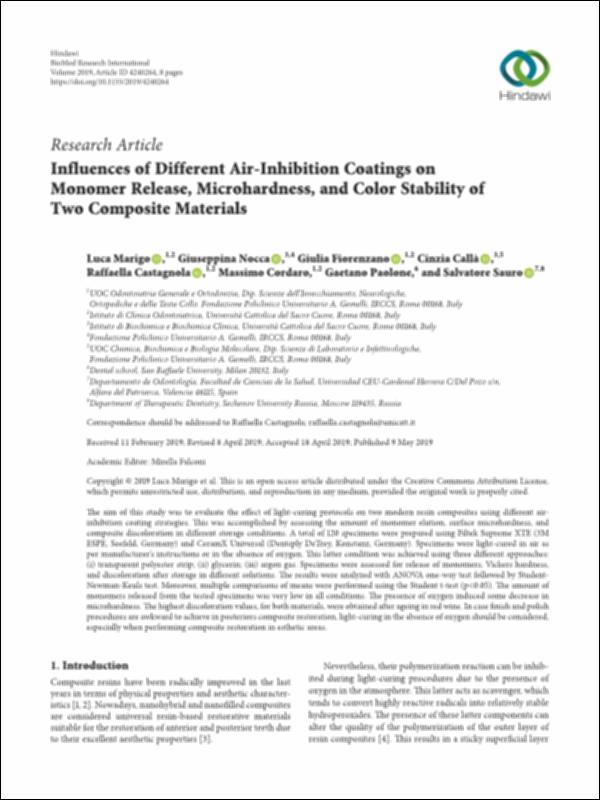Please use this identifier to cite or link to this item:
http://hdl.handle.net/10637/10764Influences of different air-inhibition coatings on monomer release, microhardness, and color stability of two composite materials
| Title: | Influences of different air-inhibition coatings on monomer release, microhardness, and color stability of two composite materials |
| Authors : | Marigo, Luca Nocca, Giuseppina Fiorenzano, Giulia Callà, Cinzia Castagnola, Raffaella Cordaro, Massimo Paolone, Gaetano Sauro, Salvatore. |
| Keywords: | Materiales dentales.; Color en Odontología.; Color in dentistry.; Dental materials.; Gums and resins in Dentistry.; Gomas y resinas - Aplicaciones en Odontología. |
| Publisher: | Hindawi. |
| Citation: | Marigo, L., Nocca, G., Fiorenzano, G., Callà, C., Castagnola, R., Cordaro, M. et al. (2019). Influences of different air-inhibition coatings on monomer release, microhardness, and color stability of two composite materials. BioMed Research International, vol. 2019 (9 may), art. 4240264. DOI: https://doi.org/10.1155/2019/4240264 |
| Abstract: | The aim of this study was to evaluate the effect of light-curing protocols on two modern resin composites using different airinhibition coating strategies. This was accomplished by assessing the amount of monomer elution, surface microhardness, and composite discoloration in different storage conditions. A total of 120 specimens were prepared using Filtek Supreme XTE (3M ESPE, Seefeld, Germany) and CeramX Universal (Dentsply DeTrey, Konstanz, Germany). Specimens were light-cured in air as per manufacturer’s instructions or in the absence of oxygen. This latter condition was achieved using three different approaches: (i) transparent polyester strip; (ii) glycerin; (iii) argon gas. Specimens were assessed for release of monomers, Vickers hardness, and discoloration after storage in different solutions. The results were analyzed with ANOVA one-way test followed by Student-Newman-Keuls test. Moreover, multiple comparisons of means were performed using the Student t-test (p<0.05). The amount of monomers released from the tested specimens was very low in all conditions. The presence of oxygen induced some decrease in microhardness.The highest discoloration values, for bothmaterials, were obtained after ageing in red wine. In case finish and polish procedures are awkward to achieve in posteriors composite restoration, light-curing in the absence of oxygen should be considered, especially when performing composite restoration in esthetic areas. |
| Description: | Este artículo se ha publicado de forma definitiva en: https://www.hindawi.com/journals/bmri/2019/4240264/ En este artículo también participan: Giuseppina Nocca, Giulia Fiorenzano, Cinzia Callà, Raffaella Castagnola, Massimo Cordaro, Gaetano Paolone and Salvatore Sauro. |
| URI: | http://hdl.handle.net/10637/10764 |
| Rights : | http://creativecommons.org/licenses/by/4.0/deed.es |
| ISSN: | 2314-6133 2314-6141 (Electrónico) |
| Issue Date: | 9-May-2019 |
| Center : | Universidad Cardenal Herrera-CEU |
| Appears in Collections: | Dpto. Odontología |
Items in DSpace are protected by copyright, with all rights reserved, unless otherwise indicated.


